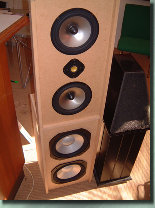Bob 1
Bob would not have been possible without one quite special piece of equipment. It is the new dbx Driverack 260 speaker management system. This is a new breed of component that combines digital crossovers, parametric EQ, delay and room correction in the one box. I know diddly about passive crossovers, but this little babe allows me to select any crossover points, at any slope up to 4th order and then fiddle away with EQ to my heart's content. I can detect no sonic consequences of the extra A/D D/A stage. In fact, I'm going to name my first born 'dbx'. Or 'hey you'.
Here's a shot of the first test baffle, next to my old Wilson speakers. I used Seas L21 RNXP mids, a Focal TC90K and Focal 10L6411 woofers since I had them lying available.
The construction could not be easier. It is two panels of 330 mm wide MDF, one for the mids and one for the bass. These are held between two side panels of MDF that are 60mm at the top, and 310 at the bottom. The speaker has a cross brace half way up and another at the bass.
And then I just screwed them together. I didn't even bother rebating the drivers.
Here you see the back of Bob. The driver simply fire into open space at the back. There is no need for cross braces or other such tom foolery.
The mid drivers are wired in parallel.
The spaghetti at the back will be fixed up later.
This is Bob's butt. It's quite a big butt as it happens. The two side panels and the cross braces combine to form an open backed cabinet, often called an H-frame cabinet.
The side wings act to extend the width of the baffle from 330mm to 900mm, which means dipole roll-off starts later and less EQ is needed.
I experiemented with various positions of the bass panel inside the H-frame, but with these drivers it seemed to sound the best at the front.
This simple baffle and cheapish drivers sounded better to me than my much loved Wilson WATTs speakers. So I sold them (the Wilsons) and moved on to the next stage.






